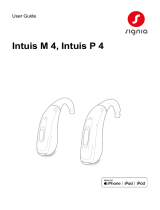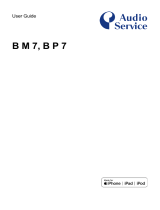
Adjustment | 29 28 | Fall Alert
Indicators
Speech indicators will play through your hearing aid(s)
when:
• You have successfully initiated a Manual Alert�
• A fall has been automatically detected�
• At least one contact has confirmed receipt of the
alert text message�
• You have successfully cancelled an alert via the user
control on the hearing aid�
A tonal indicator will play through your hearing aid(s)
when:
• There has been a communication failure during the
transmission of an alert text message�
• There has been a communication failure during the
cancellation of an alert text message�
WARNING: To reduce Fall Alert communication
failures:
• Your hearing aid(s) need to be powered on, paired
and connected with your smartphone using
Bluetooth®�
• The mobile device must be powered on, with the
Thrive app open (in the foreground or background)�
The mobile device must have a connection to the
internet (via a cellular network or WiFi)�
Pairing Your Hearing Aid with an iOS Device
To adjust your hearing aid with your iOS device, you
must pair the two together so they can communicate�
Please follow the instructions to pair your iOS device
and your hearing aid�
1� Ensure Bluetooth is enabled on your iOS device�
Within the Settings menu, go to Bluetooth and
toggle to On�
2� Locate, then tap the Settings icon on your
iOS device�
3� Within the Settings menu go to General >
Accessibility > MFi Hearing Devices.
4� While the iOS device searches for the hearing
aids, open and close the battery door on your
hearing aids� This puts the hearing aids in pairing
mode�
• You will see your hearing aid name (e�g�,
“Chris Hearing Aids”) when the iOS device
first discovers your hearing aids�
• If your name does not appear in the “Devices”
list within 5–7 seconds, tap Accessibility in
the upper left corner, then tap MFi Hearing
Devices.
You are now ready to use your iOS device to adjust
your hearing aid� You can adjust either with the native
iOS controls or with the Thrive app�






















